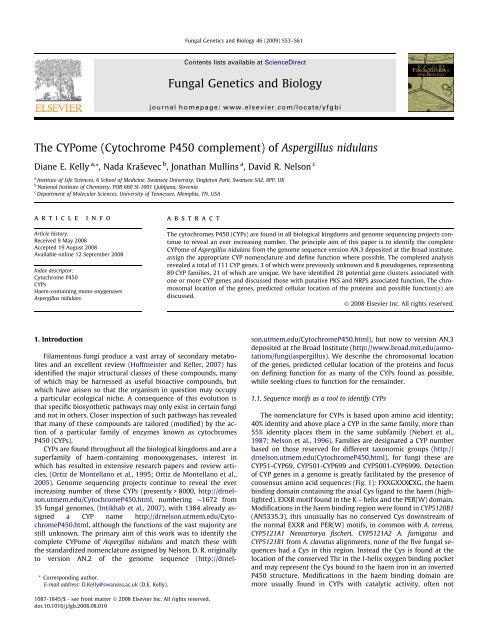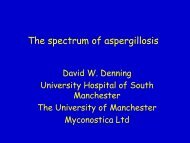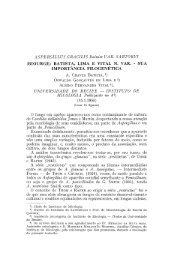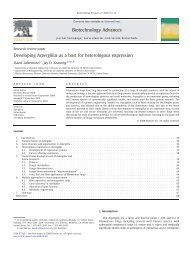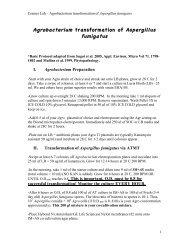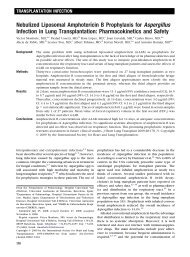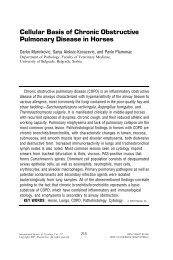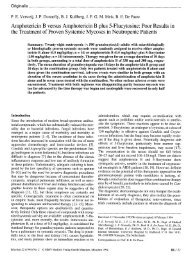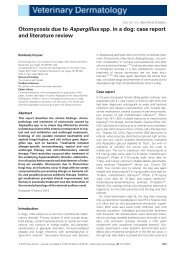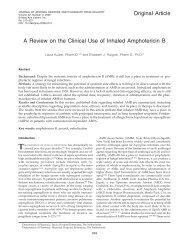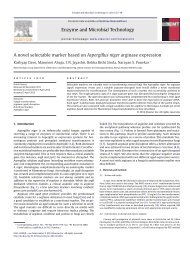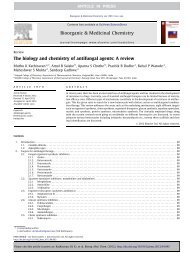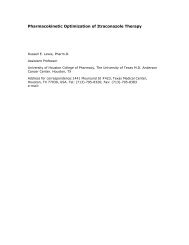The CYPome (Cytochrome P450 complement) of Aspergillus nidulans
The CYPome (Cytochrome P450 complement) of Aspergillus nidulans
The CYPome (Cytochrome P450 complement) of Aspergillus nidulans
You also want an ePaper? Increase the reach of your titles
YUMPU automatically turns print PDFs into web optimized ePapers that Google loves.
<strong>The</strong> <strong>CYPome</strong> (<strong>Cytochrome</strong> <strong>P450</strong> <strong>complement</strong>) <strong>of</strong> <strong>Aspergillus</strong> <strong>nidulans</strong><br />
Diane E. Kelly a, *, Nada Kraševec b , Jonathan Mullins a , David R. Nelson c<br />
a<br />
Institute <strong>of</strong> Life Sciences, 6 School <strong>of</strong> Medicine, Swansea University, Singleton Park, Swansea SA2, 8PP, UK<br />
b<br />
National Institute <strong>of</strong> Chemistry, POB 660 SI-1001 Ljubljana, Slovenia<br />
c<br />
Department <strong>of</strong> Molecular Sciences, University <strong>of</strong> Tennessee, Memphis, TN, USA<br />
article info<br />
Article history:<br />
Received 9 May 2008<br />
Accepted 19 August 2008<br />
Available online 12 September 2008<br />
Index descriptor:<br />
<strong>Cytochrome</strong> <strong>P450</strong><br />
CYPs<br />
Haem-containing mono-oxygenases<br />
<strong>Aspergillus</strong> <strong>nidulans</strong><br />
1. Introduction<br />
abstract<br />
Filamentous fungi produce a vast array <strong>of</strong> secondary metabolites<br />
and an excellent review (H<strong>of</strong>fmeister and Keller, 2007) has<br />
identified the major structural classes <strong>of</strong> these compounds, many<br />
<strong>of</strong> which may be harnessed as useful bioactive compounds, but<br />
which have arisen so that the organism in question may occupy<br />
a particular ecological niche. A consequence <strong>of</strong> this evolution is<br />
that specific biosynthetic pathways may only exist in certain fungi<br />
and not in others. Closer inspection <strong>of</strong> such pathways has revealed<br />
that many <strong>of</strong> these compounds are tailored (modified) by the action<br />
<strong>of</strong> a particular family <strong>of</strong> enzymes known as cytochromes<br />
<strong>P450</strong> (CYPs).<br />
CYPs are found throughout all the biological kingdoms and are a<br />
superfamily <strong>of</strong> haem-containing monooxygenases, interest in<br />
which has resulted in extensive research papers and review articles,<br />
(Ortiz de Montellano et al., 1995; Ortiz de Montellano et al.,<br />
2005). Genome sequencing projects continue to reveal the ever<br />
increasing number <strong>of</strong> these CYPs (presently > 8000, http://drnelson.utmem.edu/<strong>Cytochrome</strong><strong>P450</strong>.html,<br />
numbering 1672 from<br />
35 fungal genomes, (Intikhab et al., 2007), with 1384 already assigned<br />
a CYP name http://drnelson.utmem.edu/<strong>Cytochrome</strong><strong>P450</strong>.html,<br />
although the functions <strong>of</strong> the vast majority are<br />
still unknown. <strong>The</strong> primary aim <strong>of</strong> this work was to identify the<br />
complete <strong>CYPome</strong> <strong>of</strong> <strong>Aspergillus</strong> <strong>nidulans</strong> and match these with<br />
the standardized nomenclature assigned by Nelson, D. R. originally<br />
to version AN.2 <strong>of</strong> the genome sequence (http://drnel-<br />
* Corresponding author.<br />
E-mail address: D.Kelly@swansea.ac.uk (D.E. Kelly).<br />
1087-1845/$ - see front matter Ó 2008 Elsevier Inc. All rights reserved.<br />
doi:10.1016/j.fgb.2008.08.010<br />
Fungal Genetics and Biology 46 (2009) S53–S61<br />
Contents lists available at ScienceDirect<br />
Fungal Genetics and Biology<br />
journal homepage: www.elsevier.com/locate/yfgbi<br />
<strong>The</strong> cytochromes <strong>P450</strong> (CYPs) are found in all biological kingdoms and genome sequencing projects continue<br />
to reveal an ever increasing number. <strong>The</strong> principle aim <strong>of</strong> this paper is to identify the complete<br />
<strong>CYPome</strong> <strong>of</strong> <strong>Aspergillus</strong> <strong>nidulans</strong> from the genome sequence version AN.3 deposited at the Broad institute,<br />
assign the appropriate CYP nomenclature and define function where possible. <strong>The</strong> completed analysis<br />
revealed a total <strong>of</strong> 111 CYP genes, 3 <strong>of</strong> which were previously unknown and 8 pseudogenes, representing<br />
89 CYP families, 21 <strong>of</strong> which are unique. We have identified 28 potential gene clusters associated with<br />
one or more CYP genes and discussed those with putative PKS and NRPS associated function. <strong>The</strong> chromosomal<br />
location <strong>of</strong> the genes, predicted cellular location <strong>of</strong> the proteins and possible function(s) are<br />
discussed.<br />
Ó 2008 Elsevier Inc. All rights reserved.<br />
son.utmem.edu/<strong>Cytochrome</strong><strong>P450</strong>.html), but now to version AN.3<br />
deposited at the Broad Institute (http://www.broad.mit.edu/annotations/fungi/aspergillus).<br />
We describe the chromosomal location<br />
<strong>of</strong> the genes, predicted cellular location <strong>of</strong> the proteins and focus<br />
on defining function for as many <strong>of</strong> the CYPs found as possible,<br />
while seeking clues to function for the remainder.<br />
1.1. Sequence motifs as a tool to identify CYPs<br />
<strong>The</strong> nomenclature for CYPs is based upon amino acid identity;<br />
40% identity and above place a CYP in the same family, more than<br />
55% identity places them in the same subfamily (Nebert et al.,<br />
1987; Nelson et al., 1996). Families are designated a CYP number<br />
based on those reserved for different taxonomic groups (http://<br />
drnelson.utmem.edu/<strong>Cytochrome</strong><strong>P450</strong>.html), for fungi these are<br />
CYP51-CYP69, CYP501-CYP699 and CYP5001-CYP6999. Detection<br />
<strong>of</strong> CYP genes in a genome is greatly facilitated by the presence <strong>of</strong><br />
consensus amino acid sequences (Fig. 1): FXXGXXXCXG, the haem<br />
binding domain containing the axial Cys ligand to the haem (highlighted).<br />
EXXR motif found in the K – helix and the PER(W) domain.<br />
Modifications in the haem binding region were found in CYP5120B1<br />
(AN5335.3), this unusually has no conserved Cys downstream <strong>of</strong><br />
the normal EXXR and PER(W) motifs, in common with A. terreus,<br />
CYP5121A1 Neosartorya fischeri, CYP5121A2 A. fumigatus and<br />
CYP5121B1 from A. clavatus alignments, none <strong>of</strong> the five fungal sequences<br />
had a Cys in this region. Instead the Cys is found at the<br />
location <strong>of</strong> the conserved Thr in the I-helix oxygen binding pocket<br />
and may represent the Cys bound to the haem iron in an inverted<br />
<strong>P450</strong> structure. Modifications in the haem binding domain are<br />
more usually found in CYPs with catalytic activity, <strong>of</strong>ten not
S54 D.E. Kelly et al. / Fungal Genetics and Biology 46 (2009) S53–S61<br />
Fig. 1. Consensus amino acid sequences in <strong>P450</strong> from A. <strong>nidulans</strong>. Data were created<br />
using WebLogo (http://weblogo.berkeley.edu/) (Crooks et al., 2004; Schneider and<br />
Stephens, 1990). a - Oxygen binding and activation; b and c – ERR triad and d –<br />
Heme binding.<br />
requiring oxygen, such as prostacyclin synthases (CYP8A, Li et al.,<br />
2008) and allene oxide synthases (CYP74, Song et al., 1993) and<br />
may indicate a novel catalytic activity in this instance. Two further<br />
CYPs, CYP62C1 (AN6414.3) and CYP66A1 (AN2607.3) possess the<br />
invariant Cys, but residues upstream are replaced either by fewer<br />
amino acids in the signature GXXCXG, or by an alternative residue<br />
HXXXCXG respectively. It has been postulated that the haem binding<br />
signature requires only the invariant Cys (Rupasinghe et al.,<br />
2006).<br />
1.2. Gene assignation<br />
A complete list <strong>of</strong> all the A.<strong>nidulans</strong> CYPs is given in Table 1. <strong>The</strong><br />
total gene count is 119, including 8 pseudogenes (with in-frame<br />
stop codons, frameshifts or deletions), representing 89 CYP families<br />
(see Fig. 3 for their phylogenetic relationships), 21 <strong>of</strong> which are unique<br />
to A. <strong>nidulans</strong> and representing approximately 1% <strong>of</strong> the<br />
genome.<br />
Closer inspection <strong>of</strong> protein sequences showed there is substantial<br />
variation in sequence length across the CYPs, ranging from 286<br />
to 750 residues. All sequences were further analysed to determine<br />
incorrect exon calling, incorrect start or stop sequences and 41 sequences<br />
were identified with different gene structure requiring<br />
manual correction. Corrected proteins, after exclusion <strong>of</strong> pseudogenes<br />
and a fusion protein contained between 417– 607 residues,<br />
with an average <strong>of</strong> 511 amino acids.<br />
During the course <strong>of</strong> this work, a comparative study for four filamentous<br />
Ascomycetes by Deng et al., 2007 identified putative CYP<br />
sequences for A. <strong>nidulans</strong>. We have since determined that previously<br />
designated CYPs 539A4P (AN5478.3), 551A3P (AN5460.3),<br />
630B3P (AN2191.3), 669A1P (AN0008.3) and 686A1P (AN8510.3)<br />
were incorrect and are in fact pseudogenes. <strong>The</strong> completed analysis<br />
revealed three new CYP sequences in the updated version AN.3<br />
from Broad, these are AN10887.3, AN1703.3, AN8437.3 and named<br />
CYP5095B1, CYP5128A1 and CYP5125A1 respectively. Table 1 illustrates<br />
the linkage between all the A. <strong>nidulans</strong> CYPs, including pseudogenes,<br />
their chromosomal location and AN.3 reference number<br />
identified in this study.<br />
1.3. Protein function<br />
<strong>The</strong> natural substrates <strong>of</strong> fungal CYPs are largely unknown, but<br />
will include precursors <strong>of</strong> membrane sterols in the ergosterol biosynthesis<br />
pathway, involving CYP51 and CYP61 homologues (see<br />
below) and it can be expected that many <strong>of</strong> the CYPs will be involved<br />
in processes such as biosynthesis <strong>of</strong> pigments, antioxidants,<br />
defence compounds, toxin inactivation, virulence factors as well as<br />
in structural components <strong>of</strong> the cell (e.g. pyroverdine. dityrosine<br />
biosynthesis, see below) and signalling compounds.<br />
To date the functions <strong>of</strong> 13 CYPs from A. <strong>nidulans</strong> have been deduced<br />
experimentally and these are given in Table 1. <strong>The</strong> relatively<br />
slow progress <strong>of</strong> assigning function to specific CYPs poses a challenge,<br />
but progress has been made recently through an interesting<br />
approach by Bergmann et al., 2007. <strong>The</strong>y have shown that by<br />
inducing so-called ‘‘silent metabolic pathways” it was possible to<br />
uncover the function <strong>of</strong> a number <strong>of</strong> genes including in this instance<br />
two previously unknown CYPs, apdE (AN8411.3, CYP655A1)<br />
and apdB (AN8408.3, CYP685A1) involved in aspyridone<br />
biosynthesis.<br />
An alternative approach is to predict function based on sequence<br />
similarity to those proteins <strong>of</strong> known function. However,<br />
it is difficult and in most instances impossible, to predict the specific<br />
functions <strong>of</strong> the A. <strong>nidulans</strong> CYPs simply from their sequence<br />
similarities particularly for the novel families. It is known that a<br />
single amino acid change can significantly alter the metabolic<br />
capabilities <strong>of</strong> a CYP (Lindeberg and Negishi, 1989; Wen et al.,<br />
2005). However, for some families there is sufficient knowledge<br />
to be able to assign a putative function that may then be the subject<br />
for further experiments.<br />
<strong>The</strong> fungal sterol pathway is known to require two CYP activities.<br />
<strong>The</strong> first CYP51 is the only <strong>P450</strong> that has an orthologue (showing<br />
22-23% sequence ID between kingdoms) found in all kingdoms<br />
<strong>of</strong> life from bacteria, lower eukaryotes through fungi, plants and<br />
animals (Yoshida et al., 2000). This is thought to be the most ancient<br />
<strong>of</strong> CYPs (Aoyama et al., 1996; Nelson, 1999) and is a sterol<br />
14a-demethylase involved in the biosynthesis <strong>of</strong> cholesterol in<br />
animals, phytosterols in plants and ergosterol in fungi. CYP51 genes<br />
have been cloned from a number <strong>of</strong> fungi including Saccharomyces<br />
cerevisiae, Candida albicans and A. fumigatus (Bard et al., 1993; Mellado<br />
et al., 2001) and some <strong>of</strong> the proteins have been characterised,<br />
such that 41 conserved residues have been identified (Lepesheva<br />
and Waterman, 2004). Unlike in S. cerevisiae where only one copy<br />
<strong>of</strong> this essential gene (ERG11) is present, two CYP51 sequences are<br />
present in A. <strong>nidulans</strong> CYP51F1 (AN8283.3, cyp51B) and CYP51F2<br />
(AN1901.3, cyp51A).<br />
Hu et al. (2007) have demonstrated that both CYP51F1 and F2<br />
orthologues in A. fumigatus can act in a compensatory manner in<br />
the ergosterol pathway, i.e. neither is essential individually, but a<br />
double knockout is lethal. <strong>The</strong>y postulate that CYP51F2 (CYP51A)<br />
may encode the major 14a-demethylase activity required for<br />
growth based on accumulation <strong>of</strong> multiple missense mutations<br />
linked to azole resistance and CYP51F1 may serve a redundant role<br />
with CYP51F2 or an alternative function under particular growth<br />
conditions yet to be defined.<br />
A BLASTP search (Altschul et al., 1997) against the ERG5 yeast<br />
sequence (22-sterol desaturase) has revealed the second (single<br />
copy) CYP in the ergosterol pathway in A. <strong>nidulans</strong> (AN4042.3,<br />
CYP61A1).<br />
A third and final CYP found in S. cerevisae is involved in the biosynthesis<br />
<strong>of</strong> dityrosine, a major component <strong>of</strong> the spore wall surface<br />
(Briza et al., 1996), DIT2 or CYP56. A homologue AN2706.3<br />
(CYP56B1, 41% ID) is present in A. <strong>nidulans</strong>. Closer examination<br />
shows that the adjacent upstream gene AN2705.3 has 35% ID with<br />
DIT1 from S. cerevisae. Further homologues are also present in A.<br />
fumigatus, A. orzyae and A. fisherianus and it therefore probable that<br />
these genes code for the same function, i.e. that a dityrosine macromolecular<br />
network is also present in the <strong>Aspergillus</strong> genus.<br />
1.4. CYP clusters<br />
Deng et al. (2007) defined a gene cluster as 4 or more CYPs present<br />
within a 100 kb sliding window <strong>of</strong> genome sequence and this<br />
revealed the presence <strong>of</strong> 3 gene clusters for A. <strong>nidulans</strong>. By sorting<br />
CYPs into groups that have less than 7 genes between them (http://<br />
drnelson.utmem.edu/<strong>Cytochrome</strong><strong>P450</strong>.html), an additional 10<br />
gene clusters are observable, giving 13 in total. <strong>The</strong>se are given in)-<br />
Fig. 2 9 having only two CYPs as near neighbours, 1 having 3 CYPs,<br />
2 having 4 CYPs in a cluster and 1 has potentially 5 CYPs grouped.<br />
<strong>The</strong> function <strong>of</strong> only two <strong>of</strong> these groups is known, that for sterigmatocystin<br />
biosynthesis, (Fig. 2, cluster 5) (Brown et al., 1996) and<br />
aspyridone biosynthesis (Fig. 2 cluster 6) (BergmanN et al., 2007),<br />
the remaining groups have no function assigned and as such may<br />
be amenable to the same experimental approach. However, for
Table 1<br />
<strong>CYPome</strong> <strong>of</strong> A. <strong>nidulans</strong><br />
CYP AN.3 loc. gene CYP AN.3 loc. gene CYP AN.3 loc gene<br />
CYP680A1 AN0338.3 VIIIR CYP631B1 AN3225.3 VIR CYP59A1 AN7808.3 IVR stcS e,f<br />
CYP578C1 AN0459.3 VIIIR CYP649A1 *<br />
AN3253.3 VIR CYP60A2 AN7818.3 IVR stcF e,f,g<br />
CYP5076A1 AN0606.3 VIIIR CYP648A1 *<br />
AN3256.3 VIR CYP62A1 AN7824.3 IVR stcB e,f,g<br />
CYP684A1 AN10028.3 VIIIR CYP667A1 AN3272.3 VIR CYP548C1 AN7881.3 IIL<br />
CYP532A4 AN10259.3 VIIR CYP567E1 AN3275.3 VIR CYP682A1 AN7932.3 IIL<br />
CYP654A1 AN10389.3 VIR CYP567D1 AN3281.3 VIR CYP674A1 *<br />
AN7969.3 IIL<br />
CYP5116B1 AN10435.3 IIR CYP659A1 AN3349.3 VIR CYP541B1 AN8004.3 IIL<br />
CYP540B4 AN10479.3 IIR CYP620D1 AN3394.3 VIR CYP504A1 AN8078.3 IIL phacA k<br />
CYP682E1 AN10573.3 IIIL ivoC a<br />
CYP623B2 AN3497.3 IIR CYP652A1 *<br />
AN8139.3 IIL<br />
CYP619B1 AN10613.3 IIIL CYP681A1 *<br />
AN3609.3 IIR CYP5073A1 *<br />
AN8141.3 IIL<br />
CYP539B2 AN10617.3 IIIL CYP539D1 AN3917.3 IIR CYP653A1 AN8184.3 IIL<br />
CYP657A1 AN10647.3 V ahbB b<br />
CYP61A1 AN4042.3 IIR CYP647A1 *<br />
AN8250.3 IIL<br />
CYP59C1 AN10704.3 VR CYP660A1 AN4117.3 IIR CYP51F1 AN8283.3 IIL cyp51B i<br />
CYP619B2 AN10776.3 IL CYP675A1 AN4643.3 IIIL CYP682B1 AN8309.3 VL<br />
CYP65U1 AN10811.3 IL CYP5120B1 AN5335.3 VR CYP671A1 AN8338.3 VL<br />
CYP578B1 AN1087.3 VIIIR CYP58C1 AN5360.3 VR CYP530A3 AN8358.3 VL<br />
CYP5095B1 AN10887.3 IVL CYP673A1 AN5433.3 VR CYP685A1 *<br />
AN8408.3 VL apdB l<br />
CYP53A3 AN10950.3 IVR bzuA c,d<br />
CYP5080D1 AN5553.3 VR CYP655A1 AN8411.3 VL apdE l<br />
CYP60B1 AN11013.3 IVR stcL e,f,j<br />
CYP531D2 AN5665.3 VR CYP5125A1 AN8437.3 VL<br />
CYP547C1 AN11142.3 VIIL CYP630B2 AN5837.3 IL CYP658A1 *<br />
AN8438.3 VL<br />
CYP664A1 *<br />
AN11192.3 VIL CYP52G1 AN6057.3 IL CYP68L1 AN8530.3 VL<br />
CYP687A1 AN11220.3 VIIIL CYP671B1 AN6101.3 IL CYP677A1 AN8615.3 IIIR<br />
CYP504B1 AN1397.3 VIIIR phacB h<br />
CYP656A1 *<br />
AN6321.3 IL CYP537B1 AN8905.3 VIIL<br />
CYP503B1 AN1598.3 VIIR CYP552E1 AN6407.3 IL CYP540A2 AN8919.3 VIIL<br />
CYP620E1 AN1601.3 VIIR CYP62C1 AN6414.3 IL CYP676A1 AN8952.3 VIIL<br />
CYP5128A1 AN1703.3 VIIR CYP672A1 AN6434.3 IL CYP548D1 AN9007.3 VIIL<br />
CYP567C1 AN1737.3 VIIR CYP5077A1 *<br />
AN6449.3 IL CYP683A1 *<br />
AN9030.3 VIIL<br />
CYP666A1 AN1748.3 VIIR CYP678A1 *<br />
AN6485.3 IL CYP662A1 AN9210.3 VIL<br />
CYP682D1 AN1794.3 VIIR CYP682C1 AN6787.3 IR CYP550B2 AN9214.3 VIL<br />
CYP617D1 AN1884.3 VIIR CYP505A8 AN6835.3 IR CYP540D1 AN9218.3 VIL<br />
CYP51F2 AN1901.3 VIIR cyp51A i<br />
CYP670A1 *<br />
AN7066.3 IVL CYP679A1 *<br />
AN9225.3 VIL<br />
CYP552A2 AN2040.3 VIIR CYP52H1 AN7131.3 IVL CYP650B1 *<br />
AN9248.3 VIIIL<br />
CYP646A1 AN2596.3 VIIR CYP5078A3 AN7359.3 IVL CYP650A1 *<br />
AN9251.3 VIIIL<br />
CYP661A1 AN2607.3 VIIR CYP663A1 AN7399.3 IVL CYP651A1 *<br />
AN9253.3 VIIIL<br />
CYP566C1 AN2610.3 VIIR CYP65T1 AN7522.3 IVR CYP535D1 AN9296.3 VIIIL<br />
CYP56B1 AN2706.3 VIR CYP5080B1 AN7772.3 IVR CYP58D1 AN9313.3 VIIIL<br />
CYP665A1 *<br />
AN2727.3<br />
Pseudogenes<br />
VIR CYP573A3 AN7773.3 IVR CYP584E1 AN9384.3 VIIIL<br />
CYP669A1P AN0008.3 VIIIR CYP630B3P AN2191.3 VIIR CYP539A4P AN5478.3 VR<br />
CYP65AC3P AN10101.3 VIIIR CYP504E4P AN2347.3 VIIR CYP686A1P *<br />
AN8510.3 VL<br />
CYP548G2P AN1300.3 VIIIR CYP551A3P AN5460.3 VR<br />
*<br />
Unique families.<br />
a<br />
McCorkindale et al., 1983.<br />
b<br />
Lin and Momany, 2004.<br />
c<br />
Hynes, 1975.<br />
d<br />
Fraser et al., 2002.<br />
e<br />
Brown et al., 1996.<br />
f<br />
Keller et al., 1995.<br />
g<br />
Yu and Leonard, 1995.<br />
h<br />
Ferrer-Sevillano and Fernández-Cañón, 2007.<br />
i<br />
Mellado et al., 2001.<br />
j<br />
Kelkar et al., 1997.<br />
k<br />
Mingot et al., 1999.<br />
l<br />
Bergmann et al., 2007.<br />
the majority <strong>of</strong> the genes 90%, the function is unknown and that<br />
these may well function individually, i.e. only one CYP in a pathway<br />
(e.g. DIT2 above), or as in the case <strong>of</strong> the sterol pathway<br />
(CYP51 and CYP61) even though present on the same chromosome<br />
be spatially much further apart so as not to be considered as part <strong>of</strong><br />
a gene cluster. Indeed a check for synteny (http://sybil.sourceforge.net)<br />
<strong>of</strong> neighbouring CYPs in a number <strong>of</strong> fungi, including<br />
A. <strong>nidulans</strong>, Neosartorya fischeri, A. terreus, A. clavatus NRRL1, A.<br />
fumigatus AFU293, A. oryzae and A. niger CBS513.88, indicates that<br />
functional clusters <strong>of</strong> > 2 CYPs are limited and that the majority<br />
may function independently <strong>of</strong> other CYPs in distinct pathways.<br />
An example <strong>of</strong> this can be seen for CYP51F2 (AN1901.3). In A. <strong>nidulans</strong><br />
it is one gene away from four genes involved in phenylacetate<br />
or tyrosine degradation (Fernández-Cañón and Peñalva, 1995).<br />
<strong>The</strong>se include a 4-hydroxyphenylpyruvate dioxygenase<br />
D.E. Kelly et al. / Fungal Genetics and Biology 46 (2009) S53–S61 S55<br />
(AN1899.3), homogentisate 1,2-dioxygenase (AN1897.3), fumarylacetoacetate<br />
hydrolase (AN1896.3), and maleylacetoacetate isomerase<br />
(AN1895.3). In A. terreus, CYP51F2 (ATEG_05917) is four<br />
genes from the four aromatic amino acid catabolic genes. In A. oryzae<br />
(locus AO090003000205) and A. niger (An11g02230) the<br />
CYP51F2 is only 2 genes from the catabolic cluster. <strong>The</strong> Fernández-Cañón<br />
lab has shown that CYP504A1 (AN8078.3) is a phenylacetate<br />
2-hydroxylase and CYP504B1 (AN1397.3) catalyzes 3hydroxyphenylacetate<br />
and 3,4-dihydroxyphenylacetate 6-hydroxylations<br />
(Mingot et al., 1999; Ferrer-Sevillano and Fernández-<br />
Cañón, 2007). <strong>The</strong>se genes act upstream <strong>of</strong> the four genes mentioned<br />
above by hydroxylating the phenylacetate ring in preparation<br />
for dioxygenase ring cleavage. <strong>The</strong> CYP504 genes are not<br />
close to the catabolic cluster in A. <strong>nidulans</strong>, but CYP504B4 is only<br />
one gene away from a homogentisate 1,2-dioxygenase, fumarylac-
S56 D.E. Kelly et al. / Fungal Genetics and Biology 46 (2009) S53–S61<br />
Fig. 2. Potential <strong>P450</strong> clusters (numbered as in text), defined as CYP genes with less than 7 genes between each other (see text), as located on chromosomes. Putative redox<br />
partners (bold); Pseudogenes (P in bold). Unique families ( * ). Known function (a, b, c, d, e, f, g, h, i, j, k,l. see Table 1); L-arm <strong>of</strong> the chromosome is at the bottom. Homologue in<br />
yeast (black underlined CYP name); Possible redox partners (cpr, nr1, msr, B5red in violet). CYP near possible redox partner (violet underlined); Functional cluster (in numbered<br />
box); Polyketide synthase (PKS in grey field); Nonribosomal peptide synthetase (NRPS in violet field); Data are from Cadre (http://www.cadre-genomes.org.uk/)(Mabey et al.,<br />
2004).<br />
etoacetate hydroxylase pair in Nectria haematococca (chromosome<br />
12) and CYP504A6 is 60 kb downstream (i.e. about 20–30 genes distant,<br />
based on approximate fungal gene size 2–3 Kb) <strong>of</strong> CYP504B4<br />
in that genome. This suggests the pathway was contiguous in a<br />
common ancestor and it was broken up over time. <strong>The</strong> proximity<br />
<strong>of</strong> CYP51F2 to this catabolic cluster suggests it may participate in<br />
degradation <strong>of</strong> a substrate that is similar to phenylacetate in a<br />
manner analogous to CYP504A1, or more probably reflects synteny<br />
<strong>of</strong> unrelated genes. Despite a definitive function for CYP51F2, its<br />
presence next to a gene cluster dedicated to one function raises<br />
the issue <strong>of</strong> secondary metabolite gene clusters in fungi, a very<br />
important consideration in the analysis <strong>of</strong> <strong>P450</strong>s in fungi.<br />
Eukaryotes do not have bacterial style operons except in nematodes<br />
(Qian and Zhang, 2008). <strong>The</strong> genes <strong>of</strong> pathways tend to be<br />
scattered in most eukaryotes, though they may be regulated by<br />
common transcription factors. Fungi are an exception. <strong>The</strong> white<br />
rot fungal genome has large numbers <strong>of</strong> cytochrome <strong>P450</strong> genes<br />
and many appear in gene clusters with up to 11 CYPs (Doddapaneni<br />
et al., 2005; Yadav et al., 2006). <strong>The</strong>se clusters are mainly built<br />
by tandem duplication and the genes are not working in a single<br />
pathway to make one product. Instead they are probably working<br />
in catabolism <strong>of</strong> related substrates such as lignin degradation products.<br />
In contrast to these rather special degradative gene clusters,<br />
many secondary metabolites such as toxins and pigments are
synthesized by gene clusters in fungi. Recently the gene LaeA has<br />
been identified as a global regulator <strong>of</strong> many <strong>of</strong> these gene clusters<br />
(Perrin et al., 2007). This particular observation <strong>of</strong>fers the possibility<br />
<strong>of</strong> detecting the clusters by coordinate expression <strong>of</strong> adjacent<br />
genes on microarrays when LaeA function is perturbed. Analysis<br />
<strong>of</strong> known clusters has led to some common features that make prediction<br />
<strong>of</strong> clusters possible based on gene associations. Furthermore,<br />
the presence <strong>of</strong> some genes in the cluster may have<br />
predictive value in trying to understand what the cluster is making.<br />
We have applied this method to look for clusters <strong>of</strong> genes in A.<br />
<strong>nidulans</strong> associated with CYPs to use as a method for uncovering<br />
CYP function.<br />
2. <strong>Cytochrome</strong> <strong>P450</strong>s in proximity to PKS and NRPS genes<br />
<strong>The</strong> 13 CYP gene clusters discussed above (Fig. 2) were found by<br />
scanning for <strong>P450</strong> genes separated by seven or fewer genes. <strong>The</strong><br />
unusual property <strong>of</strong> fungi keeping secondary metabolite synthesis<br />
genes in clusters prompted the search for <strong>P450</strong>s that were near(defined<br />
here as
S58 D.E. Kelly et al. / Fungal Genetics and Biology 46 (2009) S53–S61<br />
Fig. 4. <strong>The</strong> terpene cyclase region from A. <strong>nidulans</strong> is aligned with six other genome’s homologous regions keeping the terpene cyclase as the alignment point. CYPs are<br />
indicated with filled arrows. <strong>The</strong> terpene cyclase proteins are similar to Penicillium roqueforti aristolochene synthase as indicated: A. <strong>nidulans</strong> 63%, A. clavatus 62%, A. oryzae<br />
55%, A. flavus 55%, A. terreus 63%, Penicillium citrinum 61%, Podospora anserina 54%. Sequence ID’s are indicated in S3.<br />
and decorating the result with four <strong>P450</strong> oxidations. <strong>The</strong> figure includes<br />
the region around six other fungal terpene cyclase genes.<br />
<strong>The</strong>re is remarkable similarity in the <strong>P450</strong> content near these<br />
genes. <strong>The</strong> A. clavatus cluster has all four <strong>of</strong> the CYPs in the same<br />
spatial arrangement indicating orthologous functions between<br />
the two clusters. <strong>The</strong> PKS gene is larger in A. clavatus suggesting<br />
additional modules so the PKS product is probably larger. A. clavatus<br />
has the best BLAST matches to the ZnCys MFS pair on the accession<br />
NW_001517093.1. ZnCys = XM_001267927.1,<br />
MFS = XM_001267928.1. It appears this end <strong>of</strong> the gene cluster<br />
has moved in A. clavatus. <strong>The</strong> A. <strong>nidulans</strong> and A. clavatus clusters<br />
are orthologous from the CYP667A genes to the CYP567D genes.<br />
AN3276.3, a short chain dehydrogenase (DH), is 93% identical to<br />
the A. clavatus 3845 sequence. <strong>The</strong> gene clusters in A. oryzae and<br />
A. flavus are nearly identical and they contain two <strong>of</strong> the three<br />
<strong>P450</strong> families found in A. <strong>nidulans</strong> and A. clavatus. <strong>The</strong>re is a new<br />
CYP in these two clusters and a PKS gene is not nearby. A. oryzae<br />
and A. flavus do not have a CYP667A gene in their genomes. <strong>The</strong><br />
A. oryzae ZnCys 0113 sequence and its A. flavus ortholog are 47%<br />
identical to A. clavatus 3839. <strong>The</strong>y are not related to AN3269.3 or<br />
AN3280.3.<br />
<strong>The</strong> terpene cyclase <strong>of</strong> A. terreus (sequence from AF198360.) is<br />
the known aristolochene synthase with crystal structures determined,<br />
(Shishova et al., 2008). This gene is the best match in the<br />
A. terreus genome to the other terpene cyclases in the figure and<br />
probably has orthologous function. <strong>The</strong> region around this gene<br />
is not in Genbank so the neighbouring genes are not known. However,<br />
two adjacent genes in A. terreus XM_001212369 and<br />
XM_001212370 on NT_165927 are possible orthologs <strong>of</strong><br />
AN3276.3 and AN3280.3, but the surrounding genes are not related<br />
to the genes in Fig. 4.<br />
P. citrinum makes the compound ML-236B (compactin) an<br />
inhibitor <strong>of</strong> HMG-CoA reductase and a precursor <strong>of</strong> pravastatin<br />
(Baba et al., 2006). <strong>The</strong> compactin gene cluster is just downstream<br />
<strong>of</strong> the cluster shown, following orf11 (Fig. 4). <strong>The</strong> two adjacent<br />
gene clusters seem to be regulated separately. It is relevant to note<br />
that A. terreus has a toxin cluster orthologous to the compactin<br />
cluster that makes lovastatin. It is not known, but it may be possible<br />
that the lovastatin gene cluster is just downstream <strong>of</strong> the terpene<br />
cyclase gene as seen in the orthologous cluster in P.<br />
citrinum. Note that CYP567D, CYP567E and CYP667A genes are all<br />
present as seen in the A. <strong>nidulans</strong> and A. clavatus clusters. This suggests<br />
that these other clusters may be making a similar compound<br />
as the P. citrinum cluster, but with a PKS addition. This view is<br />
strengthened by the 65% identity <strong>of</strong> orf14 to AN3279.3 and A. clavatus<br />
3848. Orf14 is also 54% identical to A. oryzae 0102 and the A.<br />
flavus ortholog. Orf11 is the best BLAST hit among patent sequences<br />
to the A. clavatus 3845 sequence, though the identity is<br />
only 31%. <strong>The</strong> synteny between these clusters suggests that orf11<br />
is a potential ortholog <strong>of</strong> AN3278.3 and A. clavatus 3847.<br />
Podospora anserina has the terpene cyclase and CYP567E as seen<br />
earlier, but it has an NRPS gene instead <strong>of</strong> a PKS. It may be related<br />
by descent, but it has changed significantly.<br />
In a second example the gene neighbourhood <strong>of</strong> CYP genes may<br />
predict the function <strong>of</strong> a secondary metabolite cluster, such as a 20<br />
gene cluster on chromosome VI from AN9210.3 to AN11201.3. This<br />
region contains five CYP genes (cluster 8 in Fig. 2). <strong>The</strong> genes in the<br />
cluster are characteristic for a metabolite cluster, i.e. a Zn(II)2Cys6<br />
binuclear cluster transcription factor (AN9221.3), a PKS<br />
(AN11198.3), an NRPS (AN9226.3), an acyl-CoA synthetase-like<br />
gene <strong>of</strong>ten seen in conjunction with PKS pathways, an efflux pump(AN9219.3)<br />
and an FAD binding monooxygenase (AN9224.3). <strong>The</strong><br />
gene that gives a clue to the function <strong>of</strong> this cluster is AN11201.3 a<br />
dimethylallyltryptophan synthase-like gene. <strong>The</strong>se enzymes catalyze<br />
the first step in ergot alkaloid biosynthesis (Coyle and Panaccione,<br />
2005) and this suggests this cluster may synthesize an<br />
alkaloid product.<br />
A final example here is taken from siderophore biosynthesis. A.<br />
<strong>nidulans</strong> makes two siderophores, an external siderophore triacetylfusarinine<br />
and an internal siderophore called ferricrocin
(Eisendle et al., 2003). Both pathways begin with the gene sidA (Lornithine-N5-monooxygenase).<br />
This gene is not a <strong>P450</strong>. Both internal<br />
and external siderophores are constructed by two different<br />
NRPS genes sidC and sidD respectively. <strong>The</strong> gene AN0607.3 is an<br />
NRPS gene orthologous to sidC (Eisendle et al., 2003). Adjacent to<br />
this gene is CYP5076A1 (AN0606.3). It is known that the internal<br />
siderophore ferricrocin is hydroxylated in A. fumigatus. <strong>The</strong> <strong>P450</strong><br />
gene CYP5076A1 is a prime candidate to perform that hydroxylation<br />
in A. <strong>nidulans</strong> and thus based on its location, it is predicted<br />
to be a ferricrocin hydroxylase. <strong>The</strong> ferricrocin hydroxylase in A.<br />
fumigatus has not been identified and there is no <strong>P450</strong> next to<br />
the sidC gene in A. fumigatus. <strong>The</strong> related <strong>P450</strong> CYP5076C2 in A.<br />
fumigatus is adjacent to a different NRPS gene called ftmA<br />
(Afu8g00170) that is the brevianamide synthetase gene (Maiya<br />
et al., 2006). This gene cluster has a dimethylallyltryptophan synthase-like<br />
gene as mentioned earlier, and it is involved in making<br />
brevianamide F, a precursor to several known alkaloids. A. fumigatus<br />
has another CYP that could be a candidate for the ferricrocin<br />
hydroxylase function: CYP5076D1 (AFUA_4G09470).<br />
We have examined some <strong>of</strong> the 20 secondary metabolite clusters<br />
predicted for A. <strong>nidulans</strong> that include at least one <strong>P450</strong> gene.<br />
<strong>The</strong>re are additional clusters that do not involve <strong>P450</strong>s. Perrin<br />
et al., 2007 have systematically searched for these clusters in A.<br />
fumigatus and found 22, though only nine contained <strong>P450</strong> genes.<br />
If each filamentous fungal genome contains 20 or more secondary<br />
metabolite clusters, there will soon be hundreds <strong>of</strong> these gene clusters<br />
to compare. <strong>The</strong> CYPs seem to be a highly variable part <strong>of</strong> these<br />
clusters. With some comparative data as gleaned from Fig. 4 it may<br />
be possible to create new metabolites by either deleting <strong>P450</strong>s or<br />
by adding <strong>P450</strong>s from homologous clusters.<br />
2.1. Redox partners<br />
For functional activity most CYPs require the input <strong>of</strong> two successive<br />
electrons from NADPH via a NADPH cytochrome <strong>P450</strong><br />
reductase and/or cytochrome b5 reducatase and cytochrome b5<br />
(Lamb et al., 1999; de Vetten et al., 1999). Mining the genome sequence<br />
<strong>of</strong> A. <strong>nidulans</strong> further we have identified 8 putative NADPH<br />
cytochrome <strong>P450</strong> reductase sequences (Fig. 2). AN0595.3 on chromosome<br />
VIII has 91% sequence ID to cprA from A. niger and 88% ID<br />
to cprA from A. fumigatus and represents the most probable candidate<br />
reductase for the majority <strong>of</strong> the CYPs. However, a second<br />
reductase with 51% sequence ID to cprA (A.fumigatus) AN5838.3<br />
is present on chromosome I and interestingly adjacent to CYP630B2<br />
(AN5837.3). We postulate that this may be specific for this CYP<br />
whose function is yet to be elucidated. AN8920.3 present on chromosome<br />
VII is immediately downstream <strong>of</strong> CYP540A2, but has the<br />
additional feature <strong>of</strong> a siderophore-interacting FAD binding domain,<br />
that may provide a clue to function. In the same way,<br />
AN3862.3 is immediately downstream <strong>of</strong> CYP540B4 (chromosome<br />
II) and might also be specific for this CYP. Lah et al., 2008 have further<br />
identified members <strong>of</strong> this protein family with similar domain<br />
architecture, which include a novel reductase 1 (NR1), AN10283.3<br />
and a methionine synthase reductase (MSR), AN2042.3, one gene<br />
away fron CYP552A2. AN11198.3 is a putative cytochrome b5<br />
reductase and neighbour <strong>of</strong> CYP540D1 AN9218.3 in the middle <strong>of</strong><br />
cluster 8 (chromosome VI) with 5 CYPs and which appears to be<br />
specific for A. <strong>nidulans</strong>. Finally, AN6835.3 is annotated as CYP505A8<br />
on chromosome I and is a member <strong>of</strong> clan CYP505, a group <strong>of</strong> CYPs<br />
that are fused to their reductase partner and found previously in<br />
Fusarium oxysporum (CYP505A1, <strong>P450</strong>foxy) (Nakayama et al.,1996;<br />
Kitazume et al., 2000) and Bacillus megaterium (CYP102, BM3, Narhi<br />
and Fulco. 1986) are responsible for fatty acid hydroxylation.<br />
Fusions between CYP genes and a reductase partner are rare,<br />
with most <strong>of</strong> the known examples being bacterial. CYP505 is the<br />
only eukaryotic family with an NADPH cytochrome <strong>P450</strong> reductase<br />
D.E. Kelly et al. / Fungal Genetics and Biology 46 (2009) S53–S61 S59<br />
fusion. It is similar to CYP102 bacterial fusions and probably represents<br />
a lateral gene transfer with later diversification in eukaryotes.<br />
<strong>The</strong> eukaryotic CYP505 clan has two families CYP505 and<br />
CYP541. CYP541 has no fusion to a reductase partner, so it may<br />
be an example <strong>of</strong> a fusion protein being broken. <strong>The</strong> next closest<br />
family to CYP505 and CYP541 is CYP540. Three <strong>of</strong> the CYP540<br />
genes were mentioned above as having reductase partners adjacent<br />
to them. It seems probable that all three <strong>of</strong> these CYP families<br />
descended from a common ancestor that had a fusion structure.<br />
CYP505 has four subfamilies. In Phanerochaete chrysosporium<br />
there are five CYP505D sequences in a 60 Kb window on scaffold<br />
3 from 150,000 to 210,000. This tandem arrangement <strong>of</strong> very similar<br />
genes argues against a pathway and in favour <strong>of</strong> a catabolic<br />
function with slightly different or overlapping substrate preferences<br />
for each. Two other CYP505D genes are elsewhere in the<br />
white rot genome. Since white rot is known for its metabolic degradation<br />
abilities as a consumer, these seven CYP505D genes probably<br />
contribute to that mechanism. In other species the CYP505<br />
genes can be biosynthetic rather than degradative. CYP505B1 is<br />
FUM6 in the fumonisin biosynthetic pathway <strong>of</strong> Fusarium verticillioides<br />
(Seo et al., 2001). FUM2 (CYP65AH1) is the fumonisin C10hydroxylase<br />
in the same pathway (Proctor et al., 2006). <strong>The</strong>re are<br />
14 named CYP505A genes in filamentous fungi. Some <strong>of</strong> them<br />
may help utilize fatty acids as a carbon source since CYP505A1, or<br />
<strong>P450</strong>foxy, is a known fatty acid hydroxylase like CYP102A1 in B.<br />
megaterium (Kitazume et al., 2008). Others may function in gene<br />
clusters to make a toxin like fumonisin as seen in some Fusarium<br />
species. Neighbourhoods near the gene should be examined for<br />
evidence <strong>of</strong> gene cluster characteristics analogous to the polyketide<br />
synthases approach used here and for fungal specific transcription<br />
factor(s).<br />
3. Subcellular localisation <strong>of</strong> A. <strong>nidulans</strong> CYPs<br />
Eukaryotic cytochromes <strong>P450</strong> are usually found bound to membranes,<br />
in most instances anchored on the cytoplasmic surface <strong>of</strong><br />
the endoplasmic reticulum (ER) through a short N-terminal hydrophobic<br />
sequence (Nelson and Strobel, 1988), while some mammalian<br />
CYPs are known to be located on the matrix side <strong>of</strong> the<br />
mitochondrial inner membrane. <strong>The</strong> latter include those involved<br />
in sterol, steroid and bile acid biosynthesis. We have undertaken<br />
a bioinformatics analysis <strong>of</strong> the amino acid sequences <strong>of</strong> all CYPs<br />
from A. <strong>nidulans</strong> in order to define possible ER signal peptides,<br />
and the presence, abundance and relationships between transmembrane<br />
regions and re-entrant loops.<br />
Using TargetP (Emanuelsson et al., 2000), cross-referenced with<br />
the two different modes (the neural network and HMM versions)<br />
<strong>of</strong> SignalP (Bendtsen et al., 2004), 75 <strong>of</strong> the proteins were predicted<br />
to possess N-terminal signal peptides. Typical microsomal CYPs<br />
possess a stretch <strong>of</strong> about 20 hydrophobic residues serving as a<br />
membrane anchor in the endoplasmic reticulum and current models<br />
still represent the triangular fold common to the CYPs lying flat<br />
on the membrane surface with the haem parallel or inclined to the<br />
membrane (Nelson and Strobel, 1988; Ohta et al., 1992). In two<br />
mammalian CYPs (CYP2C5 and CYP2B4, Williams et al., 2000) the<br />
presence <strong>of</strong> F’ and/or G’ helices form a hydrophobic surface near<br />
the N-terminus <strong>of</strong> the protein and it is thought that this portion<br />
<strong>of</strong> the CYP may lie in close proximity to the membrane and possibly<br />
be partially inserted (De-Lemos-Chiarandini et al., 1987).<br />
Transmembrane region topology prediction, using the TMHMM<br />
program (Sonnhammer et al., 1998; Krogh et al., 2001), and subsequently<br />
corrected for coincident signal peptides predicted using<br />
Signal P (Bendtsen et al., 2004) and TargetP (Emanuelsson et al.,<br />
2000), suggests that 83 <strong>of</strong> the CYPs do not possess any transmembrane<br />
regions, however using TMLoop (Lasso et al., 2006), 2 <strong>of</strong>
S60 D.E. Kelly et al. / Fungal Genetics and Biology 46 (2009) S53–S61<br />
these sequences (CYP620E1 and CYP654A1) were predicted to possess<br />
re-entrant loops, suggesting at least some anchoring to the<br />
membrane in regions other than the N-terminus signal peptide. Finally,<br />
34 <strong>of</strong> the proteins were not predicted to possess N-terminal<br />
signal peptides. Of these, one protein (CYP61A1) possesses a C-terminal<br />
XDEL motif and 4 proteins were found to contain the C-terminal<br />
ER retention KKXX motifs (searched for with a cut-<strong>of</strong>f <strong>of</strong> the<br />
last 20 residues), CYP504B1, CYP631B1, CYP5080D1 and CYP552E1.<br />
Of the four, only CYP504B1 does not also possess an N-terminal signal<br />
peptide, giving a total <strong>of</strong> 72 proteins targeted to the ER.<br />
4. Conclusion<br />
Filamentous fungi have 41 (Neurospora) to 152 (<strong>Aspergillus</strong> oryzae)<br />
<strong>P450</strong>s. Only two have established roles in housekeeping functions<br />
in sterol biosynthesis CYP51 and CYP61. <strong>The</strong> others are<br />
enzymes specific to the purpose(s) essential or useful to the fungus.<br />
Often this involves pathogenesis and the production <strong>of</strong> toxins<br />
and virulence factors, or the utilization <strong>of</strong> specific carbon sources.<br />
Many studies have been done on deciphering the gene clusters that<br />
make these toxins such as sterigmatocystin, aflatoxin and fumonisin.<br />
Frequently these clusters contain CYP genes. Here we have<br />
presented a detailed account <strong>of</strong> the A. <strong>nidulans</strong> CYPs and putative<br />
redox partners and we have identified those that are in probable<br />
gene clusters based on the nature <strong>of</strong> the neighbouring genes. Thirteen<br />
CYP gene clusters with between 2–5 CYPs are documented in<br />
Fig. 1. Fifteen more CYP clusters were found with one CYP eight<br />
genes or less from a PKS or NRPS gene (Tables S1 and S2). Eleven<br />
more clusters without any CYP genes were also found bringing<br />
the total to 39 potential gene clusters. Comparative genomic analysis<br />
for one <strong>of</strong> these clusters, that <strong>of</strong> terpene cyclase (Fig. 2) was<br />
done and illustrates linkage <strong>of</strong> genotype to function at the protein<br />
level. <strong>The</strong> toxins that given species make are <strong>of</strong>ten known and a<br />
bioinformatics comparison <strong>of</strong> the toxin lists to the clusters could<br />
provide a candidate or at least a short list <strong>of</strong> clusters to test for production<br />
<strong>of</strong> a given toxin. <strong>The</strong> occurrence <strong>of</strong> these gene clusters<br />
greatly simplifies the task <strong>of</strong> linking genotype to phenotype since<br />
the numbers are reduced from hundreds <strong>of</strong> genes to dozens <strong>of</strong> clusters,<br />
many <strong>of</strong> which are already characterized. <strong>The</strong> remaining<br />
uncharacterized clusters represent obvious targets for future work.<br />
Acknowledgments<br />
We thank Cornell, M. at E-fungi data base (http://www.efungi.org.uk/index.html)<br />
for useful discussions and the European Union<br />
(Eur<strong>of</strong>ung) is gratefully acknowledged.<br />
Appendix A. Supplementary data<br />
Supplementary data associated with this article can be found, in<br />
the online version, at doi:10.1016/j.fgb.2008.08.010.<br />
References<br />
Altschul, S.F., Madden, T.L., Schaffer, A.A., Zhang, J., Zhang, Z., Miller, W., Lipman, D.J.,<br />
1997. Gapped BLAST and PSI-Blast: a new generation <strong>of</strong> protein database search<br />
programs. Nucleic Acids Res. 25, 3389–3402.<br />
Aoyama, Y., Noshiro, M., Gotoh, O., Imaoka, S., Funae, N., Kurosawa, N., Horiuchi, T.,<br />
Yoshida, Y., 1996. Sterol 14-demethylase <strong>P450</strong> (<strong>P450</strong>14DM) is one <strong>of</strong> the most<br />
ancient and conserved <strong>P450</strong> species. J. Biochem. 119, 926–933.<br />
Baba, S., Abe, Y., Ono, C., Hosobuchi, M., 2006. Targeted disruption <strong>of</strong> the genes,<br />
mlcR and ariB, which encode GAL4-type proteins in Penicillium citrinum.<br />
Biochim Biophys Acta. 1759, 410–416.<br />
Bard, M., Lees, N.D., Turi, T., Craft, D., C<strong>of</strong>rin, L., Barbuch, R., Koegal, C., Loper, J.C.,<br />
1993. Sterol synthesis and viability <strong>of</strong> erg11 (<strong>Cytochrome</strong> <strong>P450</strong> lanosterol<br />
demethylase) mutations in Saccharomyces cerevisiae and Candida albicans.<br />
Lipids 28, 963–967.<br />
Bergmann, S., Schumann, J., Scherlach, K., Lange, C., Brakhage, A.A., Hertweck, C.,<br />
2007. Genomics-driven discovery <strong>of</strong> PKS-NRPS hybrid metabolites from<br />
<strong>Aspergillus</strong> <strong>nidulans</strong>. Nat. Chem. Biol. 3 (4), 213–217.<br />
Bendtsen, J.D., Nielsen, H., von Heijne, G., Brunak, S., 2004. Improved prediction <strong>of</strong><br />
signal peptides, SignalP 3.0. J. Mol. Biol 340, 783–795.<br />
Briza, P., Kalchhauser, H., Pittenaver, E., Allmaier, G., Breitenbach, M., 1996. N, N’-<br />
Bisformyl dityrosine is an in vivo precursor <strong>of</strong> the yeast ascopspore wall. Eur. J.<br />
Biochem. 239, 124–131.<br />
Brown, D.W., Yu, J.H., Kelkar, H.S., Fernades, M., Nesbitt, T.C., Keller, N.P., Adams,<br />
T.H., Leonard, T.J., 1996. Twenty-five co-regulated transcripts define a<br />
sterigmatocystin gene cluster in <strong>Aspergillus</strong> <strong>nidulans</strong>. Proc. Natl. Acad. Sci.<br />
U.S.A. 93, 1418–1422.<br />
Coyle, C.M., Panaccione, D.G., 2005. An ergot alkaloid biosynthesis gene and<br />
clustered hypothetical genes from <strong>Aspergillus</strong> fumigatus. Applied and Environ.<br />
Micro. 71, 3112–3118.<br />
Crooks, G.E., Hon, G., Chandonia, J.M., Brenner, S.E., 2004. WebLogo; A sequence logo<br />
generator. Genome Res. 14, 1188–1190.<br />
De-Lemos-Chiarandini, C., Frey, A.B., Sabatini, D.D., Kreibich, G., 1987.<br />
Determination <strong>of</strong> the membrane topology <strong>of</strong> the Phenobarbital-inducible rat<br />
liver cytochrome <strong>P450</strong> isozyme PB-4 using site-specific antibodies. J. Cell Biol.<br />
104, 209–219.<br />
Deng, J., Carbone, I., Dean, R.A., 2007. <strong>The</strong> evolutionary history <strong>of</strong> <strong>Cytochrome</strong> <strong>P450</strong><br />
genes in four filamentous Ascomycetes. BMC Evolutionary Biology. 7, 30.<br />
De Vetten, N., Ter Horst, J., Van Schaik, H.-P., De Boer, A., Mol, J., Koes, R., 1999. A<br />
cytochrome b5 is required for full activity <strong>of</strong> flavonoid 3’, 5’-hydroxylase, a<br />
cytochrome <strong>P450</strong> involved in the formation <strong>of</strong> blue flower colours. Proc. Natl.<br />
Acad. Sci.USA 96, 778–783.<br />
Doddapaneni, H., Chakraborty, R., Yadav, J.S., 2005. Genome-wide structural and<br />
evolutionary analysis <strong>of</strong> the <strong>P450</strong> monooxygenase genes (<strong>P450</strong>ome) in the<br />
white rot fungus Phanerochaete chrysosporium, evidence for gene duplications<br />
and extensive gene clustering. BMC Genomics. 14 (6), 92.<br />
Eisendle, M., Oberegger, H., Zadra, I., Haas, H., 2003. siderophore system is essential<br />
for viability <strong>of</strong> <strong>Aspergillus</strong> <strong>nidulans</strong>: functional analysis <strong>of</strong> two genes encoding lornithine<br />
N 5-monooxygenase (sidA) and a non-ribosomal peptide synthetase<br />
(sidC). Mol Microbiol. 49, 359–375.<br />
Emanuelsson, O., Nielsen, H., Brunak, S., vonHeijne, G., 2000. Predicting subcellular<br />
localization <strong>of</strong> proteins based on their N-terminal amino acid sequence. J. Mol.<br />
Biol. 300, 1005–1016.<br />
Fernández-Cañón, J.M., Peñalva, M.A., 1995. Fungal metabolic model for human<br />
type I hereditary tyrosinaemia. Proc. Natl. Acad. Sci. U.S.A 92, 9132–9136.<br />
Ferrer-Sevillano, F., Fernández-Cañón, J.M., 2007. Novel phacB-Encoded<br />
<strong>Cytochrome</strong> <strong>P450</strong> Monooxygenase from <strong>Aspergillus</strong> <strong>nidulans</strong> with 3-<br />
Hydroxyphenylacetate 6-Hydroxylase and 3, 4-Dihydroxyphenylacetate 6-<br />
Hydroxylase Activities. Eukaryot. Cell 6, 514–520.<br />
Fraser, J.A., Davis, M.A., Hynes, M.J., 2002. <strong>The</strong> genes gmdA, encoding an amidase,<br />
and bzuA, encoding a cytochrome <strong>P450</strong>, are required for benzamide utilization<br />
in <strong>Aspergillus</strong> <strong>nidulans</strong>. Fungal Genet. Biol. 35, 135–146.<br />
H<strong>of</strong>fmeister, D., Keller, N.P., 2007. Natural Products <strong>of</strong> Filamentous Fungi, Enzymes,<br />
Genes and their Regulation. Nat. Prod. Rep. 24, 393–416.<br />
Hynes, M.J., 1975. Amide utilization in <strong>Aspergillus</strong> <strong>nidulans</strong>: evidence for a third<br />
amidase enzyme. J. Gen. Microbiol. 91, 99–109.<br />
Hu, W., Sillaots, S., Lemieux, S., Davison, J., Kauffman, S., Breton, A., Linteau, A., Xin,<br />
C., Bowman, J., Becker, J., Jiang, B., Roemer, T., 2007. Essential gene identification<br />
and drug target prioritization in <strong>Aspergillus</strong> fumigatus. PLOS Pathogens 3, e24.<br />
Intikhab, A., Hubbard, S.J., Oliver, S.G., Rattray, M., 2007. A kingdom-specific protein<br />
domain HMM library for improved annotation <strong>of</strong> fungal genomes. BMC<br />
Genomics 8, 97.<br />
Kelkar, H.S., Skloss, T.W., Haw, J.F., Keller, N.P., Adams, T.H., 1997. <strong>Aspergillus</strong><br />
<strong>nidulans</strong> stcL encodes a putative cytochrome <strong>P450</strong> required for bisfuran<br />
desaturation during aflatoxin/ sterigmatocystin biosynthesis. J. Biol.Chem.<br />
272, 1589–1594.<br />
Keller, N.P., Segner, S., Bhatnagar, D., Adams, T.H., 1995. stcS, a putative P-450<br />
monooxygenase, is required for the conversion <strong>of</strong> versicolorin A to<br />
sterigmatocystin in <strong>Aspergillus</strong> <strong>nidulans</strong>. Appl. Env. Microbiol. 61, 3628–3632.<br />
Kitazume, T., Takaya, N., Nakayama, N., Shoun, H., 2000. oxysporum Fatty-acid<br />
Subterminal Hydroxylase (CYP505) Is a Membrane-bound Eukaryotic<br />
Counterpart <strong>of</strong> Bacillus megaterium <strong>Cytochrome</strong> <strong>P450</strong>BM3. J. Biol. Chem 275,<br />
39734–39740.<br />
Kitazume, T., Yamazaki, Y., Matsuyama, S., Shoun, H., Takaya, N., 2008. Production <strong>of</strong><br />
hydroxy-fatty acid derivatives from waste oil by Escherichia coli cells producing<br />
fungal cytochrome <strong>P450</strong>foxy. Appl. Microbiol. Biotechnol. 79 (6), 981–988.<br />
Epub 2008.<br />
Krogh, A., Larsson, B., von Heijne, G., Sonnhammer, E.L.L., 2001. Predicting<br />
transmembrane protein topology with a hidden Markov model: Application<br />
to complete genomes. J. Mol. Biol. 305, 567–580.<br />
Kumar, S., Tamura, K., Nei, M., 2004. MEGA3: Integrated s<strong>of</strong>tware for Molecular<br />
Evolutionary Genetics Analysis and sequence alignment. Brief. Bioinform. 5,<br />
150–163.<br />
Lah, L., Kraševec, N., Trontelj, P., Komel, R., 2008. High diversity and complex<br />
evolution <strong>of</strong> fungal cytochrome <strong>P450</strong> reductase: cytochrome <strong>P450</strong> systems.<br />
Fungal Genet. Biol. 45, 446–458.<br />
Lamb, D.C., Kelly, D.E., Manning, N.J., Kaderbhai, M.A., Kelly, S.L., 1999. Biodiversity<br />
<strong>of</strong> the <strong>P450</strong> catalytic cycle: yeast cytochrome b5/NADH cytochrome b5<br />
reductase complex efficiently drives the entire sterol 14-demethylase (CYP51)<br />
reaction. FEBS Lett. 462, 283–288.
Lasso, G., Antoniw, J.F., Mullins, J.G.L., 2006. A combinatorial pattern discovery<br />
approach for the prediction <strong>of</strong> membrane dipping (re-entrant) loops.<br />
Bioinformatics 22, e290–e297.<br />
Lepesheva, G.I., Waterman, M.R., 2004. CYP51-<strong>The</strong> omnipotent <strong>P450</strong> Molecular and<br />
Cellular Endocrinology 215, 165–170.<br />
Li, Y.C., Chiang, C.W., Yeh, H.C., Hsu, P.Y., Whitby, F.G., Wang, L.H., Chan, N.L., 2008.<br />
Structures <strong>of</strong> prostacyclin synthase and its complexes with substrate analog<br />
and inhibitor reveal a ligand specific heme conformation change. J. Biol. Chem.<br />
283 (5), 2917–2926.<br />
Lin, X., Momany, M., 2004. Identification and <strong>complement</strong>ation <strong>of</strong> abnormal hyphal<br />
branch mutants ahbA1 and ahbB1 in <strong>Aspergillus</strong> <strong>nidulans</strong>. Fungal Genet. Biol. 41,<br />
998–1006.<br />
Lindeberg, R.L., Negishi, M., 1989. Alteration <strong>of</strong> mouse cytochrome <strong>P450</strong>coh substrate<br />
specificity by mutation <strong>of</strong> a single amino-acid residue. Nature 339, 632–634.<br />
Mabey, J.E., Anderson, M.J., Giles, P.F., Miller, C.J., Attwood, T.K., Paton, N.W.,<br />
Bornberg-Bauer, E., Robson, G.D., Oliver, S., Denning, D.W., 2004. CADRE: the<br />
Central <strong>Aspergillus</strong> Data REpository. Nucl. Acids Res 32, D401–D405.<br />
Maiya, S., Grundmann, A., Li, S.M., Turner, G., 2006. <strong>The</strong> fumitremorgin gene cluster<br />
<strong>of</strong> <strong>Aspergillus</strong> fumigatus: identification <strong>of</strong> a gene encoding brevianamide F<br />
synthetase. Chembiochem. 7, 1062–1069.<br />
McCorkindale, N.J., Hayes, D., Johnston, G.A., Clutterbuck, A.J., 1983. N-Acetyl-6-<br />
Hydroxytryptophan–a natural substrate <strong>of</strong> monophenoloxidase from <strong>Aspergillus</strong><br />
<strong>nidulans</strong>. Phytochemistry 22, 1026–1028.<br />
Mellado, E., Diaz-Guerra, T.M., Cuenca-Estrella, M., Rodriguez-Tudela, J.L., 2001.<br />
Identification <strong>of</strong> two different 14-a sterol demethylase–related genes (cyp51A<br />
and cyp51B) in <strong>Aspergillus</strong> fumigatus and other <strong>Aspergillus</strong> species. J. Clin.<br />
Microbiol. 39, 2431–2438.<br />
Mingot, J.M., Peñalva, M.A., Fernández-Cañón, J.M., 1999. Disruption <strong>of</strong> phacA, an<br />
<strong>Aspergillus</strong> <strong>nidulans</strong> gene encoding a novel cytochrome <strong>P450</strong> mono-oxygenase<br />
catalyzing phenylacetate 2-hydroxylation, resulting in penicillin<br />
overproduction. J. Biol. Chem. 274, 14545–14550.<br />
Nakayama, N., Takemae, A., Shoun, H., 1996. <strong>Cytochrome</strong> <strong>P450</strong>foxy, a Catalytically<br />
Self-Sufficient Fatty Acid Hydroxylase <strong>of</strong> the Fungus Fusarium oxysporum. J.<br />
Biochem. 119, 435–440.<br />
Narhi, L.O., Fulco, A.J., 1986. Characterisation <strong>of</strong> a catalytically self-sufficient<br />
119,000 Dalton cytochrome P-450 monooxygenase induced by barbiturates in<br />
Bacillus megaterium. J. Biol. Chem. 261, 7160–7169.<br />
Nebert, D., Adesnik, M., Coon, M.J., Estabrook, R.W., Gonzalez, F.J., Guengerich, F.P.,<br />
Gunsalus, I.C., Johnson, E.F., Kemper, B., Levin, W., et al., 1987. <strong>The</strong> <strong>P450</strong> gene<br />
superfamily: recommended nomenclature 6, 1–11.<br />
Nelson, D.R., Strobel, H.W., 1988. On the membrane topology <strong>of</strong> vertebrate<br />
<strong>Cytochrome</strong> <strong>P450</strong> proteins. J. Biol. Chem. 263, 6038–6050.<br />
Nelson, D.R., Koymans, L., Kamataki, T., Stegeman, J.J., Feyereisen, R., Waxman, D.J.,<br />
Waterman, M.R., Gotoh, O., Coon, M.J., Estabrook, R.W., Gunsalus, I.C., Nebert,<br />
D.W., 1996. <strong>P450</strong> superfamily: update on new sequences, gene mapping,<br />
accession numbers and nomenclature. Pharmacogenetics 6, 1–42.<br />
Nelson, D.R., 1999. <strong>Cytochrome</strong> <strong>P450</strong> and the individuality <strong>of</strong> species. Arch.<br />
Biochem. Biophys. 369, 1–10.<br />
Ohta, Y., Kawato, S., Tagashira, H., Takemori, S., Kominami, S., 1992. Dynamic<br />
structures <strong>of</strong> adrenocortical cytochrome <strong>P450</strong> in proteoliposomes and<br />
microsomes: Protein rotation study. Biochemistry 31, 12680–12687.<br />
Ortiz de Montellano, P.R. and Correia, M.A. 1995 In <strong>Cytochrome</strong> <strong>P450</strong>: Structure,<br />
Function, and Mechanism, 2nd Ed.<br />
D.E. Kelly et al. / Fungal Genetics and Biology 46 (2009) S53–S61 S61<br />
Ortiz de Montellano, P.R., (Eds.), 2005 <strong>Cytochrome</strong> <strong>P450</strong>: Structure, 3rd ed.,<br />
Mechanism, and Biochemistry.<br />
Perrin, R., Federova, N., Bok, J.-W., Cramer, R.A., Wortman, J., Kim, H., Nierman, W.,<br />
Keller, N., 2007. Transcriptional regulation <strong>of</strong> chemical diversity in <strong>Aspergillus</strong><br />
fumigatus by LaeA. PLoS Pathogen 3, 50.<br />
Proctor, R.H., Plattner, R.D., Desjardins, A.E., Busman, M., Butchko, R.A., 2006.<br />
Fumonisin production in the maize pathogen Fusarium verticillioides: genetic<br />
basis <strong>of</strong> naturally occurring chemical variation. J. Agric. Food Chem. 54 (6),<br />
2424–2430.<br />
Qian, W., Zhang, J., 2008. dynamics <strong>of</strong> nematode operons: easy come, slow go.<br />
Genome Res. 18 (3), 412–421. Epub 2008 Jan 24.<br />
Rupasinghe, S., Schuler, M.A., Kagawa, N., Yuan, H., Lei, L., Zhao, B., Kelly, S.L.,<br />
Waterman, M.R., Lamb, D.C., 2006. <strong>The</strong> <strong>Cytochrome</strong> <strong>P450</strong> gene family CYP157<br />
does not contain EXXR in the K-helix, reducing the absolute conserved <strong>P450</strong><br />
residues to a single cysteine. FEBS Lett. 580, 6338–6342.<br />
Schneider, T.D., Stephens, R.M., 1990. Sequence logos: A new way to display<br />
consensus sequences. Nucl. Acids Res 18, 6097–6100.<br />
Seo, J.A., Proctor, R.H., Plattner, R.D., 2001. Characterization <strong>of</strong> four clustered and<br />
coregulated genes associated with fumonisin biosynthesis in Fusarium<br />
verticillioides. Fungal Genet. Biol. 34 (3), 155–165.<br />
Shishova, E.Y., Yu, F., Miller, D.J., Faraldos, J.A., Zhao, Y., Coates, R.M., Allemann, R.K.,<br />
Cane, D.E., Christianson, D.W. 2008. X-ray crystallographic studies <strong>of</strong> substrate<br />
binding to aristolochene synthase suggest a metal binding sequence for<br />
catalysis. J. Biol. Chem. Apr 2 [Epub ahead <strong>of</strong> print].<br />
Song, W.C., Funk, C.D., Brash, A.R., 1993. Molecular cloning <strong>of</strong> an allene oxide<br />
synthase: a cytochrome <strong>P450</strong> specialized for metabolism <strong>of</strong> fatty acid<br />
hydroperoxides. Proc. Natl. Acad. Sci. USA 90 (18), 8519–8523.<br />
Sonnhammer, E.L.L., von Heijne, G., Krogh, A., 1998. A hidden Markov model for<br />
predicting transmembrane helices in protein sequences. In: Glasgow, J.,<br />
Littlejohn, T., Major, F., Lathrop, R., Sank<strong>of</strong>f, D., Sensen, C. (Eds.), Proceedings<br />
<strong>of</strong> the Sixth International Conference on Intelligent Systems for Molecular<br />
Biology, pages 175–182. Menlo Park, CA.<br />
http://sybil.sourceforge.net Sybil is a web-based s<strong>of</strong>tware package for comparative<br />
genomics. It was developed by the Bioinformatics department at TIGR.<br />
Wen, Z., Baudry, J., Berenbaum, M.R., Schuler, M.A., 2005. Ile115Leu mutation in the<br />
SRS1 region <strong>of</strong> an insect <strong>Cytochrome</strong> <strong>P450</strong> (CYP6B1) compromises substrate<br />
turnover via changes in a predicted product release channel. Protein Eng.<br />
Design Select 18, 191–199.<br />
Williams, P.A., Cosme, J., Sridhar, V., Johnson, E.F., McRee, D.E., 2000. <strong>The</strong><br />
crystallographic structure <strong>of</strong> a mammalian microsomal cytochrome <strong>P450</strong><br />
monooxygenase: Structural adaptations for membrane binding and functional<br />
diversity. Mol. Cell. 5, 121–132.<br />
Yadav, J.S., Doddapaneni, H., Subramanian, V., 2006. <strong>P450</strong>ome <strong>of</strong> the white rot<br />
fungus Phanerochaete chrysosporium: structure, evolution and regulation <strong>of</strong><br />
expression <strong>of</strong> genomic <strong>P450</strong> clusters. Biochem. Soc. Trans. Dec. 34 (Pt 6), 1165–<br />
1169.<br />
Yoshida, Y., Aoyama, Y., Noshiro, M., Gotoh, O., 2000. Sterol 14-demethylase <strong>P450</strong><br />
(CYP51) provides a breakthrough for the discussion on the evolution <strong>of</strong><br />
<strong>Cytochrome</strong> <strong>P450</strong> gene superfamily. Biochem. Biophys. Res. Commun. 273,<br />
799–804.<br />
Yu, J.-H., Leonard, T.J., 1995. Sterigmatocystin biosynthesis in <strong>Aspergillus</strong> <strong>nidulans</strong><br />
requires a novel type I polyketide synthase. J. Bacteriol. 177,<br />
4792–4800.


